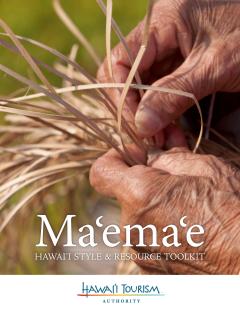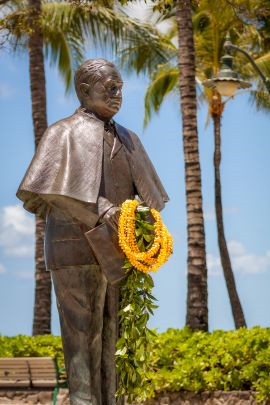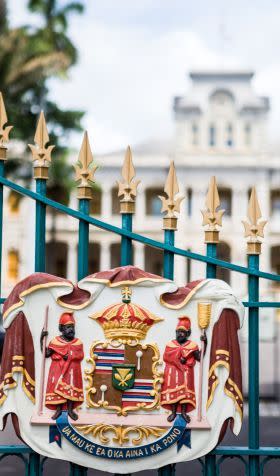Culture & Product Development
Cultural and Product Development is your connection to authentically representing Hawai‘i. Beneath the breathtaking beauty of these islands, at the core of the destination’s appeal, are the values, culture and language of the indigenous people. Access our members-only cultural services to make sure your organization is aligned with Hawai‘i’s truly unique point of differentiation.
Visit our Culture & Product Development page for more information.
 Ma‘ema‘e
Ma‘ema‘e
The Ma‘ema‘e toolkit will provide you with the essential information you need to accurately and authentically promote the Hawaiian Islands. From geographical and cultural information, to descriptions of Hawaiʻi traditions and customs, this is your guide for basic knowledge about Hawai‘i.
The toolkit, and additional Hawaiian language tools, can be downloaded from the Hawaiʻi Tourism Authority website.
Culture Training Videos
Culture 101
Culture 101
We are proud to present an overview of the Hawaiian culture, exploring various topics such as Hawaiian values, customs, traditions and protocols. The emphasis of this lesson is to better appreciate and understand the uniqueness of indigenous culture of the Hawaiian Islands.
Olelo Hawaii
ʻŌlelo Hawai‘i
Join us for a short lesson on ʻŌlelo Hawai‘i, the language of the indigenous culture of the Hawaiian Islands. We’ll cover the history and external influences on the language, as well as pronunciation and basic guidelines for the office. This bite-sized tutorial will give you a better understanding of the Hawaiian language and ways to incorporate it in your daily life.
 Warrior Marker Program
Warrior Marker Program
Under the direction of HVCB Senior Director, Brand, Kainoa Daines, the HVCB Warrior Marker Program has been refreshed. There are a total of 149 markers across the state. Each marker is a point of historical, cultural or scenic interest. The warrior marker program will be incorporated into the new GoHawaii destination app, providing a guided experience for visitors to learn more about the Hawaiian Islands.
Visit our Warrior Marker page here.
Cultural Connection
-
 We celebrate and honor the birthday of Hawaiʻi’s second delegate to Congress, affectionately known as “Prince Cupid” because of his cherubic façade. Prince Kūhiō was born in Kōloa, Kauaʻi in 1871. He was the youngest of three sons of Kauaʻi High Chief David Kahalepouli Piʻikoi and Princess Kinoʻiki Kekaulike, younger sister of Queen Kapiʻolani. He served as the Territory of Hawaiʻi’s delegate to Congress from 1903 to 1921. In 1918, he established the first Hawaiian Civic Club to stimulate civic efforts and education within the Hawaiian community and to promote Hawaiian culture. Today there are over 60 Hawaiian Civic Clubs nationwide.
We celebrate and honor the birthday of Hawaiʻi’s second delegate to Congress, affectionately known as “Prince Cupid” because of his cherubic façade. Prince Kūhiō was born in Kōloa, Kauaʻi in 1871. He was the youngest of three sons of Kauaʻi High Chief David Kahalepouli Piʻikoi and Princess Kinoʻiki Kekaulike, younger sister of Queen Kapiʻolani. He served as the Territory of Hawaiʻi’s delegate to Congress from 1903 to 1921. In 1918, he established the first Hawaiian Civic Club to stimulate civic efforts and education within the Hawaiian community and to promote Hawaiian culture. Today there are over 60 Hawaiian Civic Clubs nationwide.Because King Kalākaua and Queen Kapiʻolani had no children of their own, Jonah Kūhiō, Edward Keliʻiahonui, and David Kawānanakoa were legally adopted and given the rank of Prince. Thus, he was in line to the throne before the monarchy was overthrown in 1893.
In addition to the Hawaiian Civic Club movement, he resurrected the Royal Order of Kamehameha I after the noble organization went underground after the overthrow, and reinvigorated King Kamehameha Day festivities.
A few of his major accomplishments include a $27 million federal appropriation for the dredging and construction of Pearl Harbor and the establishing of Hawaiʻi Volcanoes National Park.
A graduate of Oʻahu College (now called Punahou School), Kūhiō is best remembered for his success in Congress passing the 1920 Hawaiian Homes Commission Act, providing homesteads for Native Hawaiians. He believed strongly in his Uncle David’s philosophy, “Hoʻoulu Lāhui – Increase the Nation.” He planned to return Hawaiians to the land, encouraging them to be self-sufficient farmers, ranchers, and homesteaders on leased parcels of reserved land, just as their ancestors had done. The act was officially signed into law by President Harding on July 9, 1921 – this year marking its 100th anniversary.
Kūhiō was also known as Ke Aliʻi Makaʻāinana or “The Citizen Prince,” because of his love for his people. He died of heart disease on January 7, 1922, at the age of 50, and is laid to rest today at Maunaʻala, the Royal Mausoleum in Nuʻuanu Valley on Oahu.
Let’s remember that Kūhiō is more than a highway on Kauaʻi, an avenue running through Waikīkī, or a mall in Hilo. He was a leader, a thinker, a doer, a Prince, a man with great foresight, and a proud son of Hawaiʻi!
-
As we say a hui hou to Ianuali, we get mākaukau to welcome Pepeluali! Although celebrated and spoken daily, each year Hawaiian Language is highlighted during the month of February as we celebrate Mahina ʻŌlelo Hawaiʻi- Hawaiian Language Month.
Designated by Governor Abercrombie in 2012, Mahina ʻŌlelo Hawaiʻi is the perfect time and opportunity for many of us to learn, practice, strengthen and share the Native language of our islands. Whether you know a little or know lot, the best thing you can do is try!
Need some kōkua? Check-out the list below for some easy hopuna ʻōlelo to slowly incorporate ʻōlelo Hawaiʻi into your daily routines:
- Aloha kakahiaka- Good morning
- Aloha e ke hoa!- Hi friend!
- Mahalo nui- Thank you very much
- I kōkua paha nāu?- Need some help?
- ʻAʻole pilikia- No problem
- E ʻai kākou- Letʻs eat!
- E kelepona mai- Give me a call
- He aha kāu leka uila?- Whatʻs your email?
-
July 31 – Lā Ho‘iho‘i Ea, Sovereignty Restoration Day commemorates the return of Hawai‘i’s sovereignty from rogue British subjects in 1843. This national holiday was celebrated from 1843 until 1867 when King Kamehameha V later replaced it with Kamehameha Day in 1872.
On July 31, 1843, King Kamehameha III proclaimed the words, “Ua mau ke ea o ka ‘āina i ka pono,” to an assembled crowd at a park in Honolulu where the Union Jack was lowered and ka hae Hawai‘i (the Hawaiian flag) was raised once again. Hawaiian sovereignty was restored by Queen Victoria’s emissary, Rear Admiral Richard Thomas. The Admiral had been sent to investigate the folly of Lord George Paulet, an English sea captain who unlawfully claimed the kingdom of Hawai‘i as an occupied colony of Great Britain.
Recent Legislation passed in 2022, officially re-designating July 31 as Lā Hoʻihoʻi Ea or Sovereignty Restoration Day as law.
-
Aloha Nowemapa kākou! As we transition into this Makahiki season, we are reminded that not only is this a time to gather with ʻohana, but it is also an opportunity to rest, reflect, and find the rejuvenation we all need to be the best hoʻokipa for our kamaʻāina and malihini.
During the next few months, think about your kuleana both in work and at home, and the intentions you set for them. Celebrate the victories and continue to work hard on the little things that can be improved. Rember to be ʻoluʻolu, mālama others, and always show aloha during this Makahiki season. Ola ʻo Lonoikamakahiki!
For more information on Makahiki, please visit: Kaʻiwakīloumoku: Makahiki Overview
-
As defined by the Pukui & Elbert Hawaiian Dictionary, lōkahi translates to “unity, agreement, accord, unison, harmony.”
Lōkahi is an agreement in unified sentiment and feeling. It’s a sense of oneness. It’s the ideal that we each bring something to the table, that we each have something to contribute, that we all matter and have a say. Through lōkahi, we aim to seek a balance amongst the input.
The Hawai‘i Revised Statues § 5-7.5 “Aloha Spirit Law” defines lōkahi, as unity, but “expressed with harmony.” Two individuals can be singing the same song, but if they’re singing in different keys, they might sound pretty awful. Finding the right melodic balance is vital for the song to work.
Through ‘ōlelo no‘eau (Hawaiian proverbs and wise sayings), let’s glean a deeper understanding of the concept of lōkahi:
‘A‘ohe hana nui ke alu ‘ia – No task is too big when done together by all. – #142
Ho‘okahi ka ‘ilau like ana – Wield the paddles together. – #1068
If everyone is out of rhythm and paddling at their own pace, the canoe will never reach its destination in a timely fashion, or at all. Dip in together and pull together. It’s the only way to move forward.
Ho‘omoe wai kāhi ke kāo‘o – Let all travel together like water flowing in one direction. – #1102
Pick a direction that works and move in that direction for the success of the greater good.
Pūpūkahi i holomua – unite in order to progress. – #2758
Listening with your heart and not just your ears will help you to achieve the balance and harmony needed for any successful endeavor. Lōkahi is about finding that sweet spot so we can move forward for the greater good.
*‘ōlelo no‘eau #977
-
You may have read the words, “Ua mau ke ea o ka ‘āina i ka pono,” on the Hawai‘i state seal, the back of the 2008 minted US Hawai‘i quarter, or in any number of places around the islands. You may have heard the words uttered at an assembly in school or sung in Israel Kamakawiwoole’s famous “Hawaii ’78.”
 The Hawaii state motto is one of the few US state mottos not in English or Latin. It’s a Hawaiian phrase uttered by a Hawaiian King back in the 1840s when Hawai‘i was an independent monarchy.
The Hawaii state motto is one of the few US state mottos not in English or Latin. It’s a Hawaiian phrase uttered by a Hawaiian King back in the 1840s when Hawai‘i was an independent monarchy.
On July 31, 1843, King Kamehameha III proclaimed the words, “Ua mau ke ea o ka ‘āina i ka pono” to an assembled crowd at a park in Honolulu where the Union Jack was lowered and ka hae Hawai‘i (the Hawaiian flag) was raised once again. Hawaiian sovereignty was restored by Queen Victoria’s emissary, Rear Admiral Richard Thomas. The Admiral had been sent to investigate the folly of Lord George Paulet, an English sea captain who unlawfully claimed the kingdom of Hawaii as an occupied colony of Great Britain.
The King appreciated the assistance of Admiral Thomas and announced the famous phrase, which for so long has been translated to, “the life of the land is perpetuated in righteousness,” but Hawaiian language scholars have begun to rethink that translation. Ea means not only “life,” but “breath” and, more importantly, “sovereignty.” Profound to think the one word, ea, could define the King’s intentions so eloquently and reconnect Hawaiians to the living, breathing, sovereign land of their kupuna.
It was adopted as the motto of the Hawaiian Kingdom from that point on and the motto of the State of Hawai‘i in 1959.
The site of this proclamation was named in the Admiral’s honor. Today Thomas Square is the oldest city park in Hawaii and one of four sites in the Hawaiian Islands where the Hawaiian flag can fly alone without the United States flag because of its Hawaiian national significance. -
Remember the invitation, for it gives you the privilege of coming here. A person feels welcome when accepting an invitation and friendly promises. – ʻŌlelo Noʻeau 349
We, Hawaiʻi’s visitor industry are the ones extending that invitation to visitors to come to our shores, to feel welcome and taken care of – mālama.
Mālama means, “to take care of, tend, attend, care for, preserve, protect, beware, save, maintain; to keep or observe, as a taboo; to serve, honor, care, preservation, support, fidelity, loyalty; custodian, caretaker, keeper.” www.wehewehe.org
During these turbulent times, we have so many things we can be grateful for and need to mālama; ourselves, our loved ones, colleagues, and this destination we have the privilege of promoting and calling our home.
Homework: Take a quiet moment and think about how you can mālama Hawaiʻi both personally and professionally?
Send your response to membership@hvcb.org for possible inclusion in an upcoming HVCB publication.
-
Every day is “lei day” in Hawaii nei, but the idea of “May Day is Lei Day,” as suggested by Honolulu Star-Bulletin columnist Grace Tower Warren and poet Don Blanding was first celebrated in 1928.
Lei, whether made of flowers, shells, or any variety of resources, are made and given with love – the ultimate personification of aloha.
However, as we approach May Day 2021 amid coronavirus and the hope of vaccines, here are a few helpful suggestions to safely celebrate a most revered Hawaiian tradition.
- Use what you have.
- Supporting local lei vendors is always welcome, but if you’re unable to get to the lei stand this year, use what you have around your home or within your neighborhood. You should obviously ask permission or know what you can and cannot pick, but making your own lei always feels good.
- Supporting local lei vendors is always welcome, but if you’re unable to get to the lei stand this year, use what you have around your home or within your neighborhood. You should obviously ask permission or know what you can and cannot pick, but making your own lei always feels good.
- Share with your loved ones.
- Still isolating? Make a lei for your ʻohana at home or wear your own homemade creation proudly. Again, there’s just as much satisfaction in wearing a lei as there is in making one.
- Still isolating? Make a lei for your ʻohana at home or wear your own homemade creation proudly. Again, there’s just as much satisfaction in wearing a lei as there is in making one.
- Be okay without the embrace.
- While we are still maintaining a safe distance from one another, it’s okay to hand someone a lei or gently lay it down for them to pick up. Customarily we would give a lei with a hug and a honi (kiss), but during this time of caution, your gesture of aloha will still be received.
So while we may not be assembling at our local parks or strutting our lei-adorned selves around town this May 1st, we can certainly keep the spirit of the day alive and well.
E lei no au i ko aloha – I will wear your love as a beautiful adornment. ʻŌlelo Noʻeau 333
- Use what you have.
-
Duke Paoa Kahanamoku was born on August 24, 1890. He grew up swimming and surfing in Waikīkī near the current Hilton Hawaiian Village Waikiki Beach Resort. Discovered as a swimming sensation, Duke's legend began when he broke the world record in the 100-yard freestyle during his very first competition. The prodigious Duke went on to win Olympic gold in the 100-meter freestyle and silver in the relay in 1912. He also won two gold medals in 1920 and won a silver medal at age 34 in the 1924 Olympics.
Read more at
https://www.gohawaii.com/islands/oahu/regions/honolulu/duke-kahanamoku-statue.Also, take a deeper dive into the sport and spirit of surfing at https://youtu.be/gIqZNUOZyw0.





